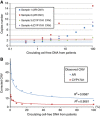Circulating cell-free AR and CYP17A1 copy number variations may associate with outcome of metastatic castration-resistant prostate cancer patients treated with abiraterone
- PMID: 25897673
- PMCID: PMC4430717
- DOI: 10.1038/bjc.2015.128
Circulating cell-free AR and CYP17A1 copy number variations may associate with outcome of metastatic castration-resistant prostate cancer patients treated with abiraterone
Abstract
Background: This study aimed to investigate copy number variations (CNVs) of CYP17A1 and androgen receptor (AR) genes in serum cell-free DNA collected before starting abiraterone in 53 consecutive patients with castration-resistant prostate cancer (CRPC).
Methods: Serum DNA was isolated and CNVs were analysed for AR and CYP17A1 genes using Taqman copy number assays. The association between CNVs and progression-free/overall survival (PFS/OS) was evaluated by the Kaplan-Meier method and log-rank test.
Results: Median PFS of patients with AR gene gain was 2.8 vs 9.5 months of non-gained cases (P < 0.0001). Patients with CYP17A1 gene gain had a median PFS of 2.8 months vs 9.2 months in the non-gained patients (P = 0.0014). A lower OS was reported in both cases (AR: P < 0.0001; CYP17A1: P = 0.0085). Multivariate analysis revealed that PSA decline ⩾ 50%, AR and CYP17A1 CNVs were associated with shorter PFS (P < 0.0001, P = 0.0004 and P = 0.0450, respectively), while performance status, PSA decline ⩾ 50%, AR CNV and DNA concentration were associated with OS (P = 0.0021, P = 0.0014, P = 0.0026 and P = 0.0129, respectively).
Conclusions: CNVs of AR and CYP17A1 genes would appear to be associated with outcome of CRPC patients treated with abiraterone.
Figures



Similar articles
-
Androgen Receptor Splice Variant 7 and Efficacy of Taxane Chemotherapy in Patients With Metastatic Castration-Resistant Prostate Cancer.JAMA Oncol. 2015 Aug;1(5):582-91. doi: 10.1001/jamaoncol.2015.1341. JAMA Oncol. 2015. PMID: 26181238 Free PMC article.
-
AR-V7 in Peripheral Whole Blood of Patients with Castration-resistant Prostate Cancer: Association with Treatment-specific Outcome Under Abiraterone and Enzalutamide.Eur Urol. 2017 Nov;72(5):828-834. doi: 10.1016/j.eururo.2017.07.024. Epub 2017 Aug 14. Eur Urol. 2017. PMID: 28818355
-
Androgen receptor gene status in plasma DNA associates with worse outcome on enzalutamide or abiraterone for castration-resistant prostate cancer: a multi-institution correlative biomarker study.Ann Oncol. 2017 Jul 1;28(7):1508-1516. doi: 10.1093/annonc/mdx155. Ann Oncol. 2017. PMID: 28472366 Free PMC article. Clinical Trial.
-
Prognostic Value of Androgen Receptor Splice Variant 7 in the Treatment of Castration-resistant Prostate Cancer with Next generation Androgen Receptor Signal Inhibition: A Systematic Review and Meta-analysis.Eur Urol Focus. 2018 Jul;4(4):529-539. doi: 10.1016/j.euf.2017.01.004. Epub 2017 Jan 23. Eur Urol Focus. 2018. PMID: 28753843
-
Role of Androgen Receptor Variants in Prostate Cancer: Report from the 2017 Mission Androgen Receptor Variants Meeting.Eur Urol. 2018 May;73(5):715-723. doi: 10.1016/j.eururo.2017.11.038. Epub 2017 Dec 16. Eur Urol. 2018. PMID: 29258679 Free PMC article. Review.
Cited by
-
Circulating AR copy number and outcome to enzalutamide in docetaxel-treated metastatic castration-resistant prostate cancer.Oncotarget. 2016 Jun 21;7(25):37839-37845. doi: 10.18632/oncotarget.9341. Oncotarget. 2016. PMID: 27191887 Free PMC article.
-
Grade group system and plasma androgen receptor status in the first line treatment for metastatic castration resistant prostate cancer.Sci Rep. 2022 May 5;12(1):7319. doi: 10.1038/s41598-022-10751-6. Sci Rep. 2022. PMID: 35513478 Free PMC article.
-
Androgen Receptor-Dependent and -Independent Mechanisms Involved in Prostate Cancer Therapy Resistance.Cancers (Basel). 2017 Jun 12;9(6):67. doi: 10.3390/cancers9060067. Cancers (Basel). 2017. PMID: 28604629 Free PMC article. Review.
-
Genetic Alterations Detected in Cell-Free DNA Are Associated With Enzalutamide and Abiraterone Resistance in Castration-Resistant Prostate Cancer.JCO Precis Oncol. 2019;3:PO.18.00227. doi: 10.1200/PO.18.00227. Epub 2019 Apr 3. JCO Precis Oncol. 2019. PMID: 31131348 Free PMC article.
-
[Predictive biomarkers in oncologic uropathology].Pathologe. 2019 May;40(3):264-275. doi: 10.1007/s00292-019-0606-3. Pathologe. 2019. PMID: 31073639 Review. German.
References
-
- Antonarakis ES, Lu C, Wang HN, Luber B, Nakazawa M, Roeser JC, Chen Y, Mohammad TA, Chen Y, Fedor HL, Lotan TL, Zheng Q, De Marzo AM, Isaacs JT, Isaacs WB, Nadal R, Paller CJ, Denmeade SR, Carducci MA, Eisenberger MA, Luo J. AR-V7 and resistance to enzalutamide and abiraterone in prostate cancer. N Engl J Med. 2014;371 (11:1028–1038. - PMC - PubMed
-
- Attard G, Reid AH, Yap TA, Raynaud F, Dowsett M, Settatree S, Barrett M, Parker C, Martins V, Folkerd E, Clark J, Cooper CS, Kaye SB, Dearnaley D, Lee G, de Bono JS. Phase I clinical trial of a selective inhibitor of CYP17, abiraterone acetate, confirms that castration-resistant prostate cancer commonly remains hormone driven. J Clin Oncol. 2008;26 (28:4563–4571. - PubMed
-
- Bishr M, Saad F. Overview of the latest treatments for castration-resistant prostate cancer. Nat Rev Urol. 2013;10 (9:522–528. - PubMed
-
- Cai C, Chen S, Ng P, Bubley GJ, Nelson PS, Mostaghel EA, Marck B, Matsumoto AM, Simon NI, Wang H, Chen S, Balk SP. Intratumoral de novo steroid synthesis activates androgen receptor in castration-resistant prostate cancer and is upregulated by treatment with CYP17A1 inhibitors. Cancer Res. 2011;71 (20:6503–6513. - PMC - PubMed
Publication types
MeSH terms
Substances
Grants and funding
LinkOut - more resources
Full Text Sources
Other Literature Sources
Research Materials
Miscellaneous

